|
|
|

|
|
 |
|
| Overall
obverse views of sword in and out of scabbard
|
|
|
This sword is 35-3/8" overall. The hilt is 5-3/4" and the 29-5/8"
blade measures 3/4" in width at the hilt.
|
|
|
|
|
|
|
|
|
The beautiful sword scabbard is inscribed, on the reverse, lengthwise:
"Presented / TO / M.F. Linquist M.D./ by his personal friends
/ as a token of regard" Next to that, inscribed between
vertical inscriptions of "Committee" and "Sept
8th 1861", are inscribed, one under the other, the names "R.S.
Dunham, G.W. Dunham, J.H. Embree, S.S. Wendell, E.C. Serviss and N.O.
Benjamin".
|
|

Overall View of Inscription
|
|
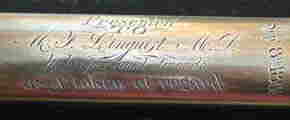
Presented To Inscription |

Presented From Inscription |
|
The mystery is in the inscription. I can find no references in military records to M.F. Linquist (or Linguist, or Lindquist) M.D. Neither have I found any references for any members of the committee. Who was this Doctor? Who were his friends? The sword is in very fine condition. Was it ever really carried? Did the Doctor ever serve? For now it's a mystery. Maybe some day I will find out, I hope so.
|
|
|
|
|
|
|
|
|
The scabbard is gilded brass. The center of the 2-1/2" long upper
band is 2-3/8" from the throat. It is decorated with geometric
and floral designs and bears 2 opposing carrying (suspension) rings.
The 5-3/16" long middle band is 7-1/4", center to center, from the
upper band. It has similar decorations and a single carrying ring.
The 6" long drag is decorated with a spray of oak leaves and acorns.
The bands and drag are each separate pieces of molded gilded brass
that have been slid onto the scabbard. They are secured by screws
on the reverse of the scabbard.
|
|
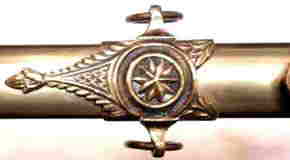
Top Band & Carrying Rings (Obverse View) |

Middle Band with Carrying Ring (Obverse View) |
|
|
|
|
|
|
|
|
|
|
The hilt is comprised of 4 separate gilded brass castings: the
acorn shaped pommel, the grip, a decorative spacer between the grip
and the cross guard and the cross guard itself with cast in shields.
The grip is molded with acanthus leaves and decorative incising. On
the obverse is a oval medallion featuring an American eagle. A similar,
but plain oval is on the reverse. An engraving of the owner's choice
can be added here, such as his name or initials. The acorn shaped
pommel is actually a nut that secures the hilt to the tang of the
sword blade. The guard consists of two graceful scrolled quillons
4-3/8" across decorated in an overlapping leaf motif, with two 1-1/2"x
1-5/8" langet shields - one on each side. The reverse shield is plain
with a raised border. The obverse shield bears the cast in letters
of "MS" in old English script above 12 stars with all being encircled
by laurel sprays.
|
|
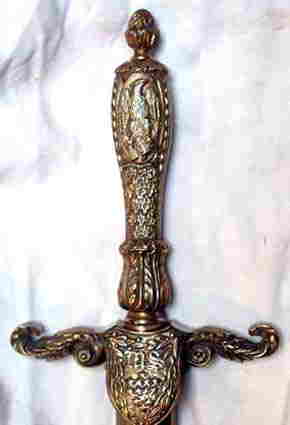
Obverse View
|
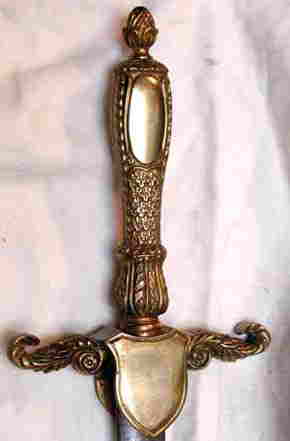
Reverse View
|
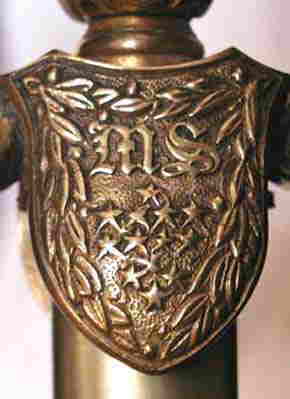
Close Up Of Shield Langet (MS - Medical Staff)
|
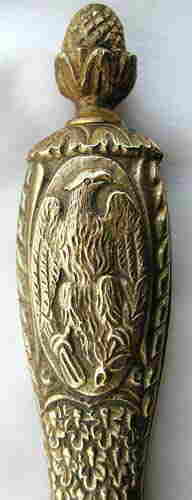
Close Up Of Eagle
|
|
|
|
|
|
|
|
The straight 29-5/8" 2 sided blade is elliptical in cross section.
It tapers evenly from it's 3/4" width at the hilt to a point.
There are no grooves or fullers. The blade is decorated on the
reverse with a standing stemmed flower and leaves at the bottom of
the blade, and above that an American eagle holding a ribbon in his
beak within which is "E PLURIBUS / UNUM". Above the ribbon is
a stand of military trophies, topped by an arrangement of oak leaves.
On the obverse, there is a similar standing flower arrangement at
the bottom of the blade (with some pitting). Above that in script,
in an extended panel, is "United States Medical Staff" under
an arrangement of oak leaves.
|
|

"United States Medical Staff" Engraving (On Obverse - Center Panel )
|
|

Standing Flower - Obverse (Bottom of Blade - Pitted)
|
|

Oak Leaves - Obverse (Top of Blade)
|
|

|
(Lower Center)
|

Standing Flower - Reverse (Bottom of Blade)
|
|

Oak Leaves - Reverse (Top of Blade)
|
|

Stand Of Arms - Reverse (Upper Center) |
|
|
|
|
|
|
|
|
This Medical Staff sword design was adopted in 1840. It remained regulation
for medical officers of the United States Army for 62 years with minor
variations. The earlier specimens, such as this sword, had somewhat
heavy blades elliptical in cross section. Post Civil War production
is marked by light frail blades, diamond shaped in cross section.
The blade etching went from the robust relatively shallow etching
of the 1840's and 50's to lighter and more detailed etching with dulled
backgrounds in later years.
|
|
|
These swords are highly collectable and in demand be they Civil war
pre, or post.
|
|
|
The presentation sword pictured and described herein has no maker's
name or trade mark. The only markings are a small number "6"
just below the throat on the scabbard reverse and a somewhat large
irregular "21" on the obverse inside tang along with a hard to decipher
stamping on the reverse tang that appears to be "GBST." The
latter 2 stampings can only be seen by removing the pommel screw and
the remaining 3 pieces of the hilt.
|
|
|
|
|
|
The American Sword 1775-1945 by Harold Peterson was
the primary reference used for this posting. The webmaster responsible
for posting the write-ups and associated pictures to this web page
is my son, Reed Radcliffe. Without his expertise and help this posting
would never get here.
|
|
| Dave
Radcliffe
|
|
